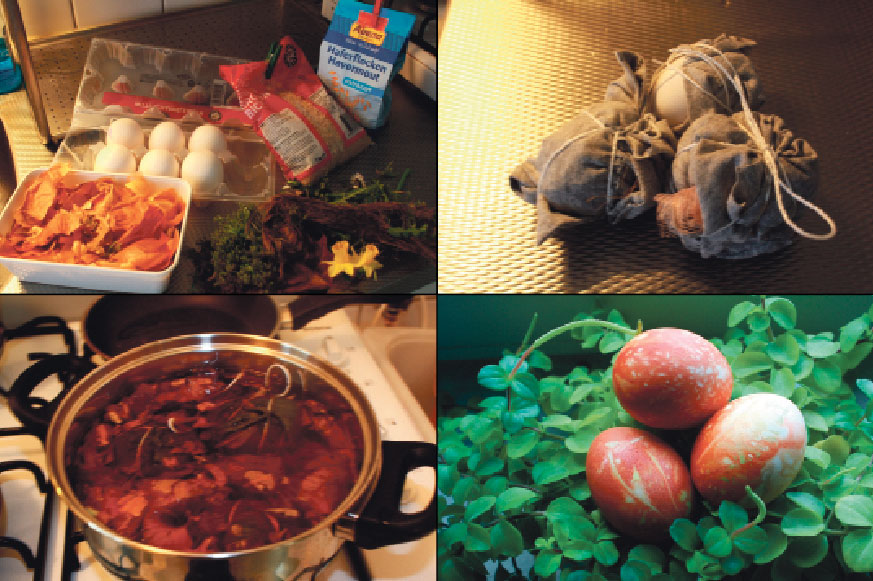Several Latvian Easter traditions have been maintained throughout the years, making the Easter celebration very enjoyable. If one wants to avoid mosquito and horse-fly bites in the summer, on the Easter day one has to swing high on the swings.
If one wants to have a soft skin without sores, one has to eat at least 13 cranberries before the sunrise on the Easter morning. But if one wants to have wealth and good relations with friends and relatives, one has to colour, eat and exchange eggs.
The traditional Latvian way of colouring eggs is to wrap them in a piece of fabric together with some materials from nature and boil them in onion peels. In order to make your egg the most beautiful, you will have to let your imagination go wild. For the colouring and patterns on the egg, you can use everything you can find in nature – leaves, grass, moss, flowers, small sticks and branches… So instead of going to the shop to get special bright colouring pens and paint, you can spend time outdoors collecting the necessary items. You can also use several items of food that can create funny patterns on the egg, for instance rice, oat flakes or muesli, nuts, beans, etc. The most exciting part in the colouring process is to unwrap the egg after it has boiled in the onion peels to see the patterns that have been created.
With the coloured eggs are ready, the games can begin! Find a sloped surface in a park or create one yourself using a board. Put your egg on the top of the slope and let it go. You can either try to have the egg that will roll the furthest, or you can hit someone else’s egg, participating in a strongest egg contest. Keep your egg vertical and ask a friend to hit it with his egg with a reasonable force. You have two ends to play with – the round end and the pointed end of the egg, but make sure you are both hitting the same ends together. The player whose egg is undamaged, or has only one end cracked, wins the game. Finally, the eggs can be eaten, but don’t forget to use salt when eating the egg, or else otherwise (according to Latvian tradition) you will tell lies all summer!
Ingredients:
-
White eggs (as much as you want to colour) -
Onion peels (brown and dark purple) -
Piece of fabric and string -
Materials for patterns (rice, oat flakes, crushed pasta, grass, leaves, twigs, flowers etc.)
Preparation:
First thing you need to do is to cut a piece of fabric, which you will wrap around the egg. Then put water in a pot and a handful or two of onion peels, and let the water boil. In the meantime, prepare the eggs. For the best result, use white eggs. Take a piece of fabric and put on it some of the materials you have for creating patterns; for example, sift a little bit of rice. Then on top of the rice put one egg. Put several leaves on the top of the egg. Enclose the egg with the fabric and tie its end with a piece of string, so the materials that are inside do not fall out. Put the eggs in the boiling water and boil for 10-12 minutes. Afterwards, take the eggs out and cool them in cold water. Take off the piece of fabric and have a look at your creation! In order to make the eggs shiny, you can rub them with a piece of a pig skin.
Run next to your bike and let it go. Most bikes will continue straight ahead. Now give it a sideward smack. Such abuse is ruefully tolerated as the bike will steer itself back on the right track. Although the stability of bicycles has been studied for almost 150 years, a bit of a mystery still remains. Last week, TU Delft researchers, Dr Arend Schwab and Jordi Kooijman (Msc), together with American colleagues, added another sequel to the bicycle studies in Science.
It was commonly believed, they explain, that the gyroscopic effect of the wheels is essential for a bike’s balance, as is a certain amount of trailing (the point of contact of the front tire is some centimetres behind the steering axis). A clever experiment however has proven that neither aspect is essential for balancing the bike, although both aspects do generally help.
The mathematical model of a standard bicycle, as published by Schwab in 2007, has no less then 25 parameters. Researcher Jim Papadopoulos (University of Wisconsin) reduced that number to eight in what was, when built, a weird looking contraption. Delft researchers from the 3mE faculty then built that ‘bike’ to test its stability. Its design has no gyroscopic effect (each wheel is balanced by a similar wheel rotating the other way) and no trailing (the wheel touches ground in front of the steering axis). Hence, if the ‘bike’ is stable (which it is), apparently neither the gyroscope effect nor the trailing is essential for a bicycle’s balance.
So what is essential? Basically, as Professor Andy Ruina from Cornell University explains, it’s the ability to bring the bike’s wheels back underneath it. Schwab says the same thing but differently: a bicycle should steer towards its fall. Once a bike banks over (after a smack on the side), it is essential that the steering wheel falls even quicker than the rest of the bike. By steering into the fall the bicycle brings its wheels once again underneath it and restores the equilibrium.
bicycle.tudelft.nl/stablebicycle
J.D.G Kooijman, J.P. Meijgaard, Jim M. Papadopoulos, Andy Ruina, A.L. Schwab: A Bicycle Can Be Self-Stable Without Gyroscopic or Caster Effects, Science, 15 April 2011



Comments are closed.